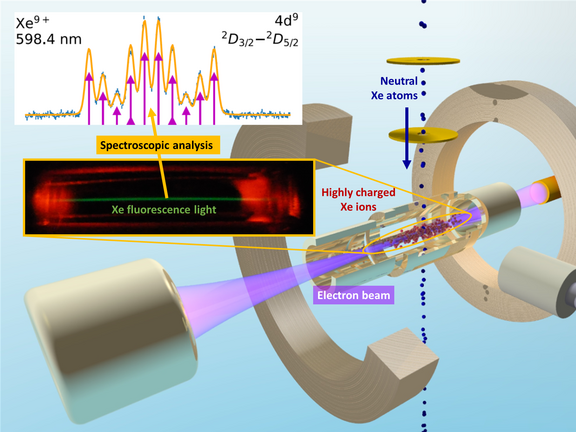Physics describes the known elementary particles and their fundamental interactions with the so-called Standard Model (SM). Although it works very well for high-energy experiments, such as those at CERN, and in the atomic and molecular realms, it does not explain the dominance of matter over antimatter, nor neutrino oscillations and apparent evidence for dark matter. Beyond the current search for new physics at colliders, new high-precision experiments in atomic physics are increasingly testing the limits of the SM and exploring possible alternatives and extensions to it.
One general possibility is a hypothetical fifth force between electrons and neutrons. It would lead to additional tiny shifts in the frequencies of atomic transitions, depending on the number of neutrons in the nucleus. In recent years, a number of experiments have determined such isotopic shifts (IS) with many orders of magnitude greater accuracy than was previously possible. The classical tool for their analysis, the so-called King plot, parametrizes the well-known effects of nuclear mass and finite nuclear size, and obtains a linear relationship for these isotopic shifts. With the recent tremendous increase in accuracy, the King plot becomes a microscope for the smallest interactions beyond the SM description.
Highly charged xenon candidate for probing the fifth force
In a new study published in Physical Review Letters, physicists from the Max Planck Institute for Nuclear Physics (MPIK), the Physikalisch-Technische Bundesanstalt (PTB) and the University of New South Wales (UNSW) have identified highly charged xenon ions as an excellent candidate for probing the fifth forces. "The King plot requires enough data points to infer the presence of an unknown interaction coupling bound electrons to the neutrons in the nucleus," explains Nils Rehbehn, a PhD student in José Crespo's group at MPIK. "This means: As many electronic transitions and as many stable isotopes with an even mass number as possible." Xenon is ideal for this because it has seven such isotopes.
Theory suggests new spectroscopic analysis with improved precision
Fifth forces would induce non-linear behavior of the King plot. But poorly understood higher-order SM effects ("spurions") could also induce nonlinearities that mimic fifth forces. To overcome this, Julian Berengut (UNSW) developed a new generalized, multidimensional King plot that uses more transitions and isotope pairs to build a larger set of linear equations suitable for isolating these higher-order SM effects: "We don't even need exact knowledge of the nuclear masses. With seven stable even isotopes of Xe, we can tackle up to three spurions using a five-dimensional King plot."
The physicists searched for, found, and accurately measured thirteen "forbidden" optical transitions. "These lines are a million times weaker than normal optical emission lines, and we measured their wavelengths with a precision that will help us find them later with ultra-narrow lasers," says group leader José Crespo, explaining the main purpose of this challenging investigation. "One of the ground-state excitations has a lifetime of 500 s - a potential clock candidate that further enhances our proposed scheme."
Ongoing search for atomic transitions as probes of new physics and nuclear properties
The Xe isotopes thus form the most comprehensive system for probing hypothetical fifth forces, even in the presence of spurions. PhD student Michael Rosner on the next goals: "We will continue our search for atomic transitions that are sensitive to other manifestations of the fifth force. Our spectroscopy can also accurately measure nuclear properties, such as nuclear deformation, on the way to more sensitive searches for physics beyond the SM".
Original publication:
Narrow and Ultranarrow Transitions in Highly Charged Xe Ions as Probes of Fifth Forces
Nils-Holger Rehbehn, Michael K. Rosner, Julian C. Berengut, Piet O. Schmidt, Thomas Pfeifer, Ming Feng Gu and José R. Crespo López-Urrutia
Physical Review Letters 131, 161803 (2023). DOI: 10.1103/PhysRevLett.131.161803
Weblinks:
Group „Highly charged ion dynamics“ at MPIK
